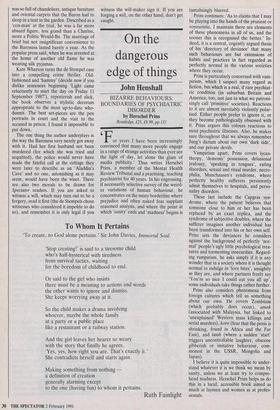The stripping of Aunt Puss
Mark Archer
BLOOD MONEY: THE STORY OF THE BARONESS DE STEMPEL SCANDAL by Kate Wharton
Ebury Press, f14.99, pp. 192
At Boot Magna it was Nannie Bloggs, Scoop readers will recall, who was said to own 'the money'. She got great delight from telling each member of the family, severally and secretly, that he or she was her heir. Susan Wilberforce, Baroness de Stempel, titled by her second marriage and a descendant of the slave trade reformer, had her own Nannie Bloggs in Lady Margaret Illingworth, her 80-year-old `Aunt Puss'. Nannie Bloggs kept her sav- ings in a red flannel bag under the bolster; Aunt Puss put her half-a-million pounds' worth of antiques in store and lived off her cash and investments in the company of two geriatric helpmates in Kensington. The old lady was ripe for taking, which, not to put too fine a point on it, is what the Baroness did:
There she was one day [her secretary remem- bers], next day she was gone — it just seemed so unbelievable to me. . . She was hijacked! I mean, you don't suddenly come along out of the blue and scoop people up to the other end of the country, together with their belongings and papers, if there wasn't something strange about it — it just, as far as I was concerned, it just wasn't done.
Why didn't she do anything then? If fate spared you from playing the villain in this tragedy it seems to have delivered you up to something much worse, not a curse exactly, more a miasma, a moral sleeping- sickness. No one even slightly connected with the Wilberforces appears to have escaped.
The Baroness had spent her whole life selling what family silver she possessed to make ends meet. Didn't all families behave in the same way, she maintained to the police after her arrest?
Stripped of her finery, Lady Illingworth spent 23 months in a state-run old people's home before she died. She was cremated, despite her wish to be buried alongside her husband in the family mausoleum in Brad- ford. The staff receiving no instructions, they scattered her ashes in the garden of remembrance. The bill remains unpaid. The Baroness' modest cottage, meanwhile, was so full of chandeliers, antique furniture and oriental carpets that the Baron had to sleep in a tent in the garden. Described as a `con-man' at the trial, he was a far more absurd figure, less grand than a Charlus, more a Politic Would-Be. The marriage of brief but not insignificant convenience to the Baroness lasted barely a year. As the popular press said, when he was arrested at the home of another old flame he was wearing silk pyjamas.
Kate Wharton turns the de Stempel case into a compelling crime thriller. Old- fashioned and 'hammy' (decide now if you dislike sentences beginning 'Light came reluctantly to start the day on Friday 11 September 1987'), reporterish and slick, the book observes a stylistic decorum appropriate to the most up-to-date who- dunnit. The best set-pieces are the pen portraits in court and the visit to the accused in prison. I found it impossible to put down.
The one thing the author underplays is the way the Baroness very nearly got away with it. Had her first husband not been murdered (for which she was tried and acquitted), the police would never have made the fateful call at the cottage they were later to describe as an 'Aladdin's Cave' and no one, astonishing as it may seem, would have been the wiser. There are also two morals to be drawn for Spectator readers. If you are asked to witness a will, which may turn out to be a forgery, read it first (the de Stempels chose witnesses who considered it impolite to do so), and remember it is only legal if you witness the will-maker sign it. If you are forging a will, on the other hand, don't get caught.



















































 Previous page
Previous page